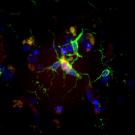For these studies, researchers used data from participants in the UW ADRC Clinical Core, with gratitude.
As published in Dimensions Magazine for Fall/Winter 2023.
Improving diagnostic accuracy of cognitive testing for Latinx/o/a in the United States

Marquine MJ, et al. Alzheimer’s & dementia: the journal of the Alzheimer’s Association, 2023
A team of researchers from Alzheimer’s Disease Research Centers (ADRCs) across the country have taken an important step toward improving the accuracy of memory and thinking testing among Spanish- and English-speaking Latinos in the United States.
All ADRCs use a set of the same memory and thinking tests to assess the cognitive functioning of participants enrolled in their memory study, and to track any changes over time. This standard group of tests is designed to detect cognitive impairment. But because most participants in ADRC studies are non-Hispanic white, it is uncertain whether the test results mean the same thing for people in historically minoritized groups.
In the study, 437 healthy Latino adults, recruited from across 33 ADRCs, completed the test in their preferred language. The researchers then used the scores in mathematic models that found associations of age, years of formal education, and sex with scores on the cognitive tests. They were able to see patterns within these groupings by demographic characteristics. For example, more years of education were linked to better test scores among Spanish-speakers.
Other researchers will be able to use these new data to ensure the test accurately reflects cognitive ability among Latinos enrolled in ADRCs. Such efforts are needed to address disparities in Alzheimer’s disease.
ADRC-affiliated researchers involved: Walter Kukull
Understanding mid-life obesity and dementia risk

Batabyal, RA et al. Int. Journal of molecular sciences, 2023
Research shows that being severely overweight or obese in middle age is associated with a three-fold increased risk of dementia 30 years later.
To better understand the link between midlife obesity and the increased risk of Alzheimer’s disease, a team of researchers studied samples of blood and cerebrospinal fluid of 18 ADRC research participants living with Alzheimer’s disease, as well as 14 healthy control subjects.
In these fluid samples, the team looked for exosomes, or cellular vesicles that carry key proteins and genetic information from cell to cell. They were able to isolate the exosomes specifically released from fat cells, and then they analyzed the molecular cargo inside.
In the samples from participants with Alzheimer’s disease, they found evidence that genetic messages carried by fat-cell derived exosomes affect the working of a key pathway involved in the health of neurons, learning, and memory. These findings suggest a way that midlife obesity can increase the risk of Alzheimer’s disease and identify a treatment target. This study was made possible by an ADRC Development Project Award.
ADRC-affiliated researchers involved: C. Dirk Keene, Suman Jayadev, Kimiko Domoto-Reilly, Gail Li, Elaine Peskind, Dedra Buchwald, Robert Freishtat
Finding Clues to Alzheimer’s in the Brain’s Immune Cells

Image courtesy of Alexandra Cochoit, UW Neurology. See bigger
Prater, KE et al. Nature aging, 2023
Microglia are a type of cell that play very important roles in our brain health. They have a diversity of jobs, including maintaining normal brain function, fighting infections, and cleaning up and disposing of dead cells and waste. Research suggests that in people with Alzheimer’s disease pathology in their brains, some microglia react too strongly, causing so much inflammation that the response drives the disease, rather than preventing it.
An ADRC research team used brain autopsy samples from 22 ADRC research participants to learn more about the groups of microglia that respond to Alzheimer’s disease. To do so, they studied the microglia gene expression, or the messages that get turned into proteins for use in the cell to perform in their specific job.
In a new paper, the team describes three different groups of microglia that have not been seen before in the human brain. All three groups showed signs of being involved in waste disposal duties. But one of these groups appeared more often in brains of people who had Alzheimer’s disease during life. The gene expression of these microglia also showed signs of inflammatory activity. This finding is a new clue to how microglia respond to Alzheimer’s pathology. They also looked at a population of microglia known to help send messages between cells, and they found a subgroup only found in Alzheimer’s disease brain tissue.
“Instead of using medications to treat the whole immune cell population, we can now target just the type of microglia that are harmful,” says lead author Katherine Prater, PhD. The team is now positioned to study microglia’s role in Alzheimer’s disease, with more precision than ever before. •
ADRC-affiliated researchers involved: Katherine Prater, Kevin J. Green, Sainath Mamde, Alexandra Cochoit, Carole L. Smith, Shannon E. Rose, C. Dirk Keene, Jessica Young, Ali Shojaie, Gwenn Garden, Suman Jayadev





